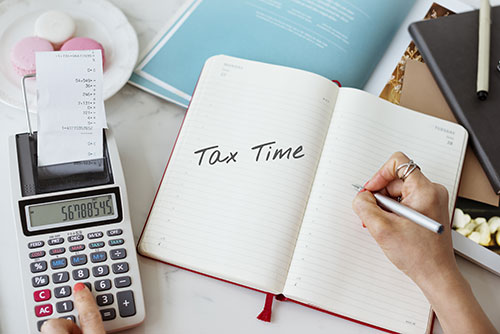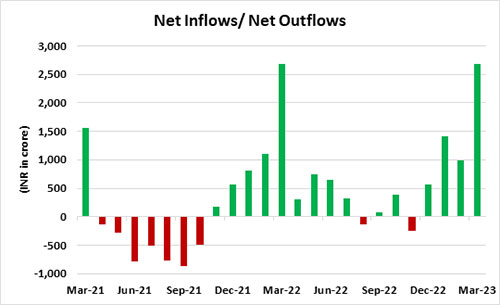Why Invest in Tax-Saving Mutual Funds at the Start of the Financial Year
Mitali Dhoke
Apr 14, 2023 / Reading Time: Approx. 10 mins
Listen to Why Invest in Tax-Saving Mutual Funds at the Start of the Financial Year
00:00
00:00
To be able to live a steady financial life, each of us strives to accumulate a sizeable savings corpus. However, while savings is key for a successful financial plan, it's not enough. Another important consideration is tax planning; without one, you can end up paying a significant amount in income tax, which would deplete your savings and leave you with less money to plan your future.
The new financial year 2023-24 has just begun, and this is the right time to indulge in your tax planning. However, many salaried individuals put off this task until the last minute, delaying your tax planning can leave you scrambling at the eleventh hour. And as a result of your uncertainty, you might invest in tax-saving avenues that don't necessarily support your financial goals.
It makes much more sense to choose tax-saving assets that fit your risk profile, time horizon, and goals than to invest haphazardly. If properly managed, a considerable sum of money can be saved through the numerous routes available for income tax savings. In addition, it's possible that your financial situation will change during the course of the fiscal year. Moreover, if you are a salaried employee, you can get your paycheque with taxes deducted in the fourth quarter of the year.
Did you know that there are various elements of your salary that can be used to lower your income tax obligation? For domestic travel with your family (spouse, dependent parents, children, or siblings), you can use the Leave Travel Allowance (LTA) as a tax exemption twice every 4 years. You can also deduct taxes from your salary for things like your House Rent Allowance (HRA), your child's schooling, phone bills, etc. Early tax planning will help you identify these exemptions efficiently and request a pay restructure from your company as necessary. Thus, the beginning of the fiscal year is the ideal time to begin making your tax-saving investments.
Tax planning is an important aspect of a financial plan; it is crucial to learn about various tax-saving options before investing. Section 80C of the Income-tax Act allows a tax deduction of up to Rs 1.5 lacs in a financial year. In fact, most salary earners start saving or investing under Section 80C immediately after their first salary. If you are seeking to save taxes this financial year, you can consider investing in tax-saving mutual funds or ELSS.
 Image source: www.freepik.com
Image source: www.freepik.com
Join Now: PersonalFN is now on Telegram. Join FREE Today to get 'Daily Wealth Letter' and Exclusive Updates on Mutual Funds
What is ELSS?
Equity Linked Savings Schemes (ELSS) are a special category of equity mutual fund schemes that provide tax benefits to investors and are commonly known as tax-saving mutual funds. As per SEBI's norms, an ELSS invests a minimum of 80% of its asset in equity and equity-related instruments.
ELSS offer the dual advantage, tax-saving benefit under Section 80C and potential for wealth creation. Plus, there is a mandatory lock-in period of 3 years. Investing in tax-saving mutual funds like ELSS is a smart way to enter the equity market for the long term.
Graph: Investor sentiment towards ELSS
 Data as of April 14, 2023
Data as of April 14, 2023
PersonalFN Research
(Source: AMFI)
According to monthly data issued by the Association of Mutual Funds in India (AMFI), there was a drastic decline in net positive inflows for ELSS in 2021. With the exception of March 2021, the ELSS category has consistently seen outflows up until December 2021. The drop in inflows has been on account of various factors such as rising interest rates, weakening rupee, geopolitical tension, etc.
Notably, investors seeking to reduce their tax burden increase their investments in ELSS over the last three months or fourth quarter of the financial year. The ELSS category saw inflows of Rs 1,098 crore in February 2022 followed by Rs 2,676 crore in March 2022. Further, we can see a decline in net inflows for the ELSS category. This is because, the new tax regime does not offer any tax deductions under Section 80C for ELSS and few other investments.
However, Investors must shift their perspective to see ELSS as a wealth-creating tool rather than just a tax-saving option. During the high volatility periods, ELSS ensures the discipline of staying put for the investment horizon, ensuring the investor reaps the benefits of long-term investment because of the 3-year lock-in. AMFI saw net inflows of Rs 2,686 crore into ELSS for the month of March 2023.
What are the benefits of investing in tax-saving mutual funds or ELSS at the beginning of the year?
1. Tax Benefit
Just like other tax-saving options under the wide umbrella of Section 80C, ELSS too offers the benefit of claiming tax deductions of up to Rs 1.5 lacs per financial year.
Further, the income earned under this scheme at the end of the 3-year tenure is considered as Long Term Capital Gain (LTCG). However, these gains in ELSS are only partially taxable (LTCG on equity or equity mutual funds up to Rs 1 lac is tax-free). LTCGs above Rs 1 lac per annum are liable to be taxed at 10% without indexation.
2. Lower Lock-in Period
The lock-in period for ELSS is 3 years, which is shorter than the lock-in periods for some of the other tax-saving investment products, such as PPF (15 years), Tax-Saving Fixed Deposits (5 years), and NSC (5 years). The lock-in period of 3 years will begin on the date of investment of each SIP instalment rather than the date of SIP registration if an investor has made investments in ELSS through the Systematic Investment Plan (SIP). Keep in mind, nevertheless, that investors cannot liquidate or pledge the units they purchased through such schemes during the lock-in period.
In addition, while other tax-saving fixed deposits come with a lock-in period of 5 years, ELSS, with a shorter lock-in period, offers better liquidity. Some investment options under Section 80C may be automatically liquidated/redeemed once the lock-in period has ended. The investor may or may not need to take any further action in response to this. Investors in ELSS must submit a special redemption request in order to withdraw money from the fund. However, the investors may continue to stay invested in ELSS even post the lock-in period to achieve their financial goals.
3. Portfolio Diversification
As a rule of investing, you don't put all your eggs in one basket. The majority of ELSS spread their corpus over a variety of stocks, including those from large-cap, mid-cap, and small-cap companies, as well as among other asset classes (including equity and debt), sectors, and themes. One can diversify their investment portfolio and lower market risk by using ELSS.
4. Potential for High Returns
ELSS has the potential to generate significant returns over the long run, being an equity scheme. Other tax-saving tools that do not invest in equities, however, might not have the same potential. The return potential of investing in ELSS is higher than that of conventional options. Fixed-Income investment instuments like PPF and FDs offer a much lower post-tax return. ELSS is also easy to understand and invest in.
ELSS have the potential to earn higher returns which are a result of the risk taken by the fund houses by investing in equities. However, the risk associated with such funds is higher when compared to other tax-saving instruments. ELSS, along with tax benefits, facilitates an investor to earn market-linked returns. Although it is impossible to predict future returns for ELSS, historical returns can be used to assess past performance.
Table: Performance track record of Top ELSS over the long-term
Do note past performance is not an indicator of future returns
Data as on April 14, 2023
PersonalFN Research
(Source: ACE MF)
5. Assists in Wealth Creation
ELSS offers a shorter lock-in period, but if your ELSS is performing well, you can think about holding it post-the lock-in period to take advantage of the higher returns and watch your wealth grow. Even though ELSS investments are designed to reduce taxes, earnings are tax-free up to a certain amount. ELSS has the potential to generate enticing inflation-adjusted returns if your goal is to build wealth.
6. Aligns to Your Financial Goals
When considering investing in ELSS, you should take your investment objectives into account. These schemes are ideal for achieving your long-term financial goals, such as buying a home, funding for your children's higher education, wedding expenses, or even retirement, due to the possibility of higher returns from ELSS investments over the long run. For example, you should go for ELSS with a lower risk profile and a longer investment period if you are looking for a long-term investment.
One of the best things about ELSS is a hassle-free investment; you can begin your tax planning journey quite easily. You can also choose whether you wish to start your investment as a SIP or lumpsum amount over your preferred time period in ELSS. You may even use a mutual fund calculator to obtain a feel of how much your investment can grow within a specific period, which is essential when planning for significant financial goals.
PS: Tax saving is an integral part of one's wealth creation journey. Equity Linked Saving Scheme (ELSS), also known as Tax-Saving Mutual Fund, is one of the most worthy avenues for tax saving. PersonalFN's Definitive Guide, '3 Best ELSS to Invest in 2023', offers a list of carefully selected ELSS to invest in 2023.
This Guide will show you how to pick a worthy ELSS, a tax-saving mutual fund, that could potentially maximise your wealth and act as an effective tool for tax planning. If you are looking to invest in ELSS, then Subscribe now! To PersonalFN's Definitive Guide '3 Best ELSS to Invest in 2023'.
MITALI DHOKE is a Research Analyst at PersonalFN. She is an MBA (Finance) and a post-graduate in commerce (M. Com). She focuses primarily on covering articles around mutual funds including NFOs, financial planning and fixed-income products. Mitali holds an overall experience of 4 years in the financial services industry.
She also actively contributes towards content creation for PersonalFN’s social media platforms in the endeavour to educate investors and enhance their financial knowledge.